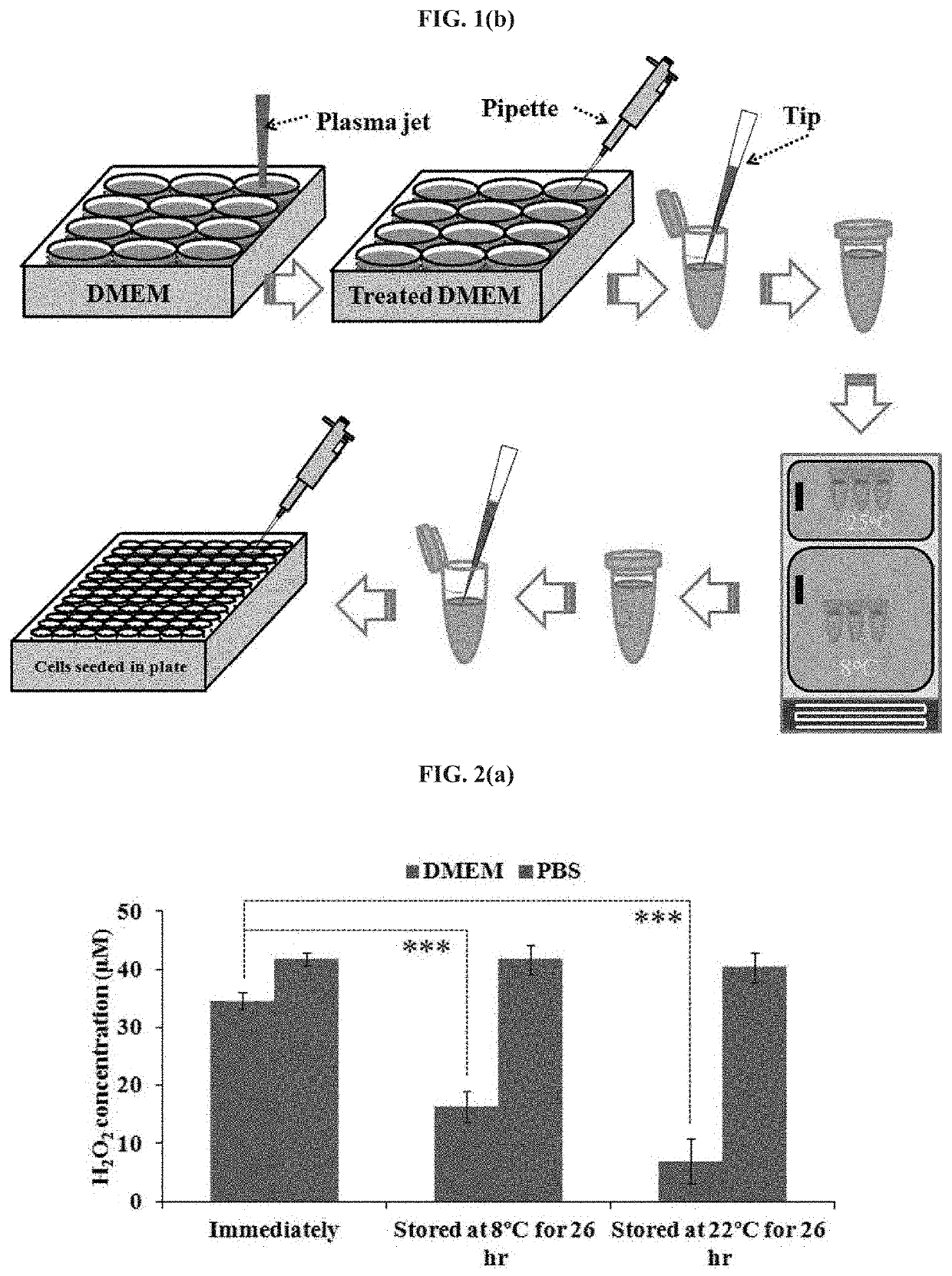Stabilized Anti-cancer cold atmospheric plasma (CAP)-stimulated media and methods for preparing and using same
a technology of atmospheric plasma and stabilized anticancer, which is applied in the field of stabilized anticancer cold atmospheric plasma (cap)stimulated media, can solve the problems of degradation of psm for future clinical applications during storage, and no method has been reported to date regarding improving stability
- Summary
- Abstract
- Description
- Claims
- Application Information
AI Technical Summary
Benefits of technology
Problems solved by technology
Method used
Image
Examples
examples
[0063]The present invention will now be further described by way of the following non-limiting examples. In applying the disclosure of these examples, it should be kept clearly in mind that the examples are merely illustrative of the present invention and should not be construed as limiting the scope of the invention in any way as many variations and equivalents that are encompassed by the present invention will become apparent to those skilled in the art upon reading the present disclosure.
The CAP Device
[0064]The CAP device (FIG. 1a) is a helium CAP jet generator which has been used in a series of studies (see, e.g., Refs. 17, 18 and 32-34). The CAP jet is generated between the central electrode and the grounded ring electrode. The carrying gas is helium with a flow of 4.7 L / min, controlled by a flow meter. The output voltage is 3.16 kV. Any suitable CAP device can be utilized, such as shown in, e.g., International Publication No. WO 12 / 167089, which is hereby incorporated by refer...
example i
nism of PBS Degradation
[0073]To understand the mechanism of PSM degradation, H202 generation in CAP-stimulated DMEM and PBS after 26 hours of storage (at 8° C. or 22° C.) was compared. As can be seen from FIG. 2, the H202 in the CAP-stimulated PBS was stable during storage. In contrast, most of the H202 in the plasma-stimulated DMEM had been lost after 26 hours storage at either 8° C. or 22° C. (FIG. 2a). The higher storage temperature for PSM, the more degradation occurs in PSM (FIG. 2a). The CAP-stimulated PBS has higher a H202 concentration than the CAP-stimulated DMEM (FIG. 2a).
[0074]The H202 concentration in the CAP-stimulated PBS was not only stable over 7 days of storage at 8° C. (FIG. 2b) but also stable over 3 days at −25° C. (FIG. 2c). The stable anti-cancer capacity of the CAP-stimulated PBS over 3 days at 8° C. and −25° C. was further confirmed by using the corresponding treated PBS to affect the growth of breast cancer (MDA-MB-231) cells (FIG. 2d). In addition, FIG. 2e ...
example 2
t of Components in DMEM on the Degradation of PBS
[0075]The effect of several specific components in DMEM on the PSM degradation was also investigated. A comparison between DMEM and PBS reveals that 15 amino acids, glucose, calcium ion, magnesium ion, and phenol red are the main composition differences between DMEM and PBS.
[0076]Accordingly, 15 specific amino acids solutions, 1 glucose solution, 2 saline solutions (CaCh, MgCh), and 1 phenol red solution were respectively made by adding or dissolving the specific component in PBS according to their concentrations in the standard DMEM. After the CAP treatment and subsequent 26 hours of storage at 22° C., the H202 concentrations in these solutions were measured and compared with the corresponding H202 concentration in the solution immediately following the CAP treatment (FIG. 3a). The H202 in the CAP-stimulated PBS is relatively stable over the storage. In contrast, most of the studied components cause different levels of H202 degradati...
PUM
 Login to View More
Login to View More Abstract
Description
Claims
Application Information
 Login to View More
Login to View More - R&D
- Intellectual Property
- Life Sciences
- Materials
- Tech Scout
- Unparalleled Data Quality
- Higher Quality Content
- 60% Fewer Hallucinations
Browse by: Latest US Patents, China's latest patents, Technical Efficacy Thesaurus, Application Domain, Technology Topic, Popular Technical Reports.
© 2025 PatSnap. All rights reserved.Legal|Privacy policy|Modern Slavery Act Transparency Statement|Sitemap|About US| Contact US: help@patsnap.com



